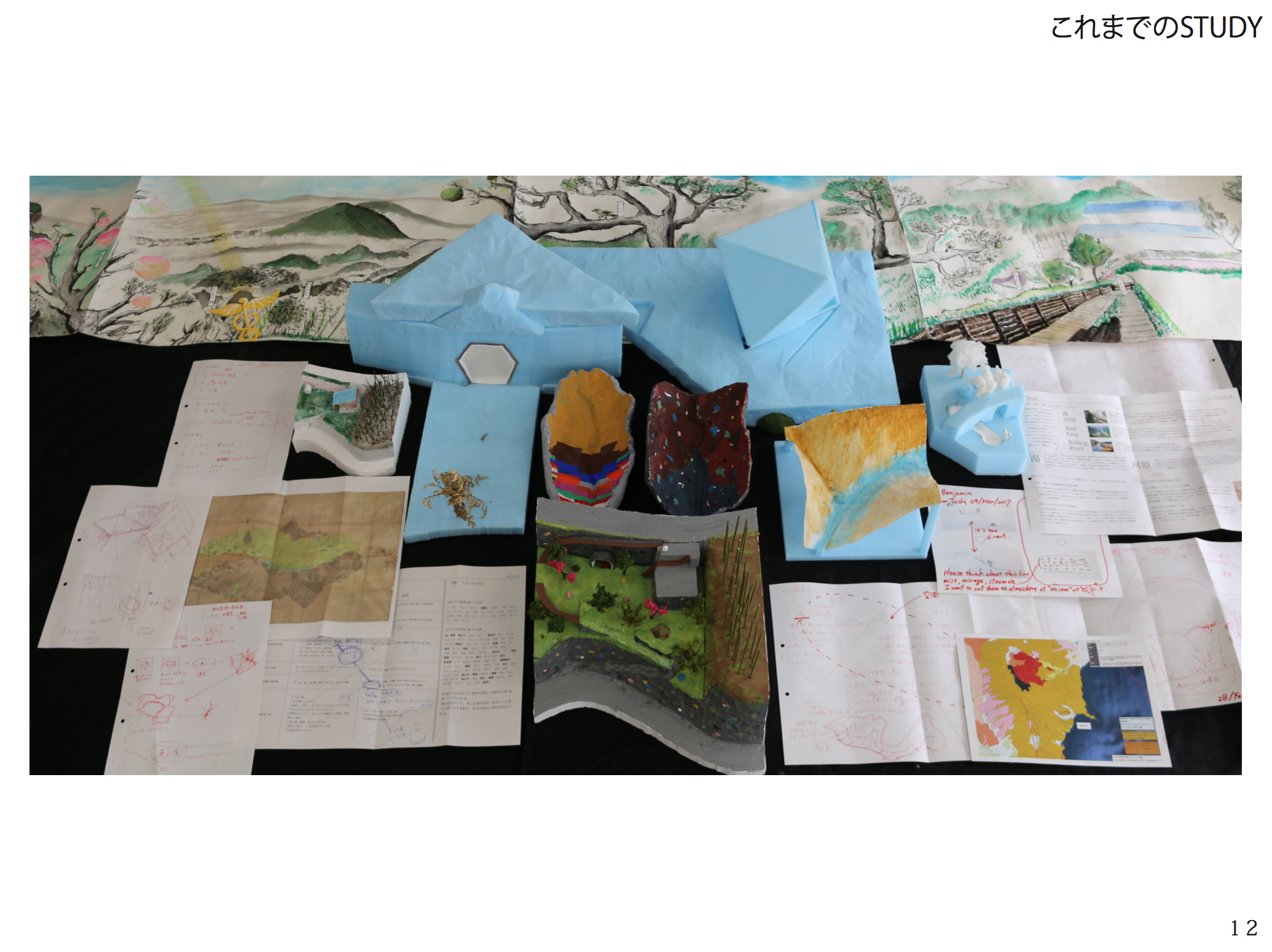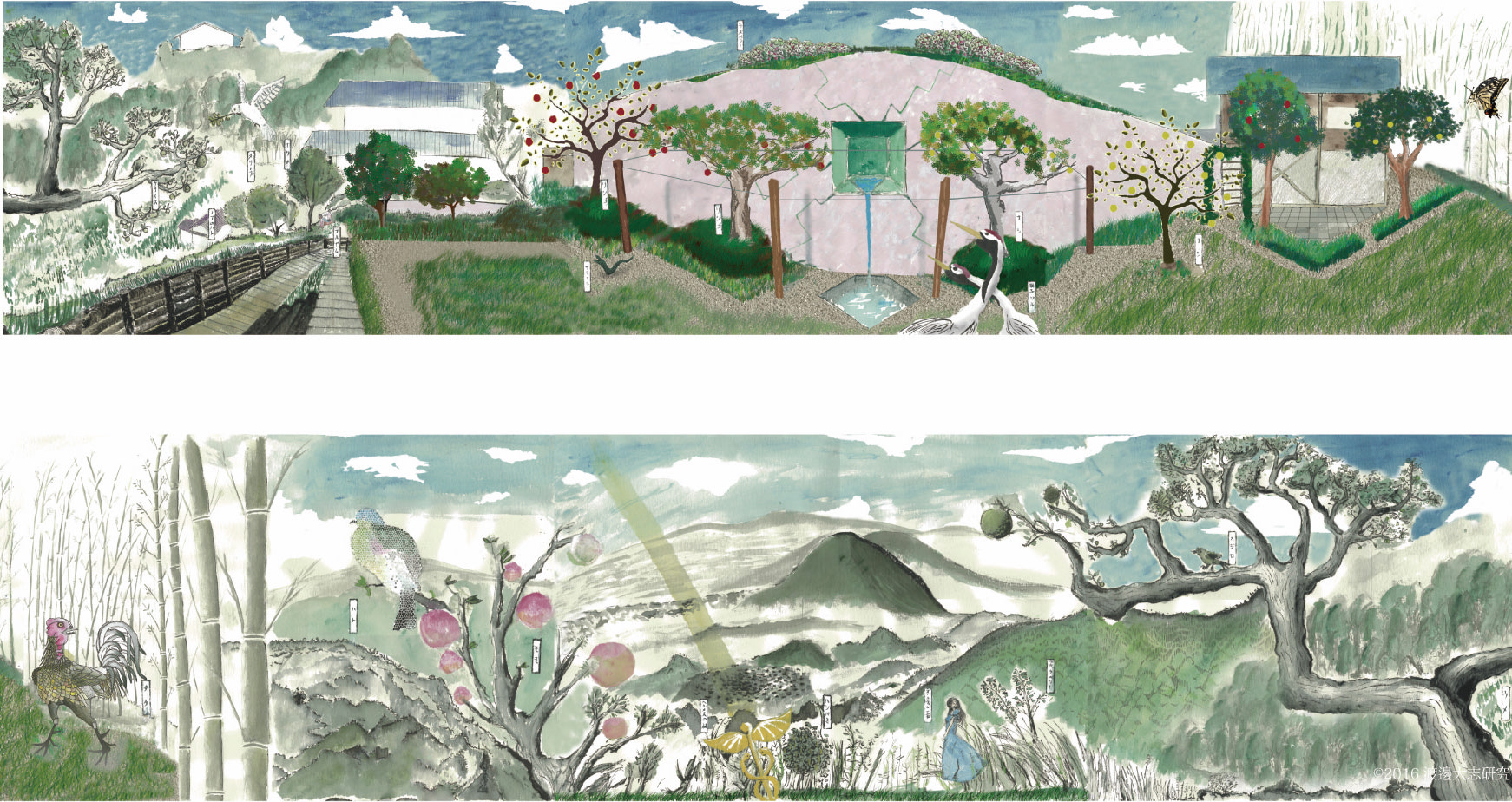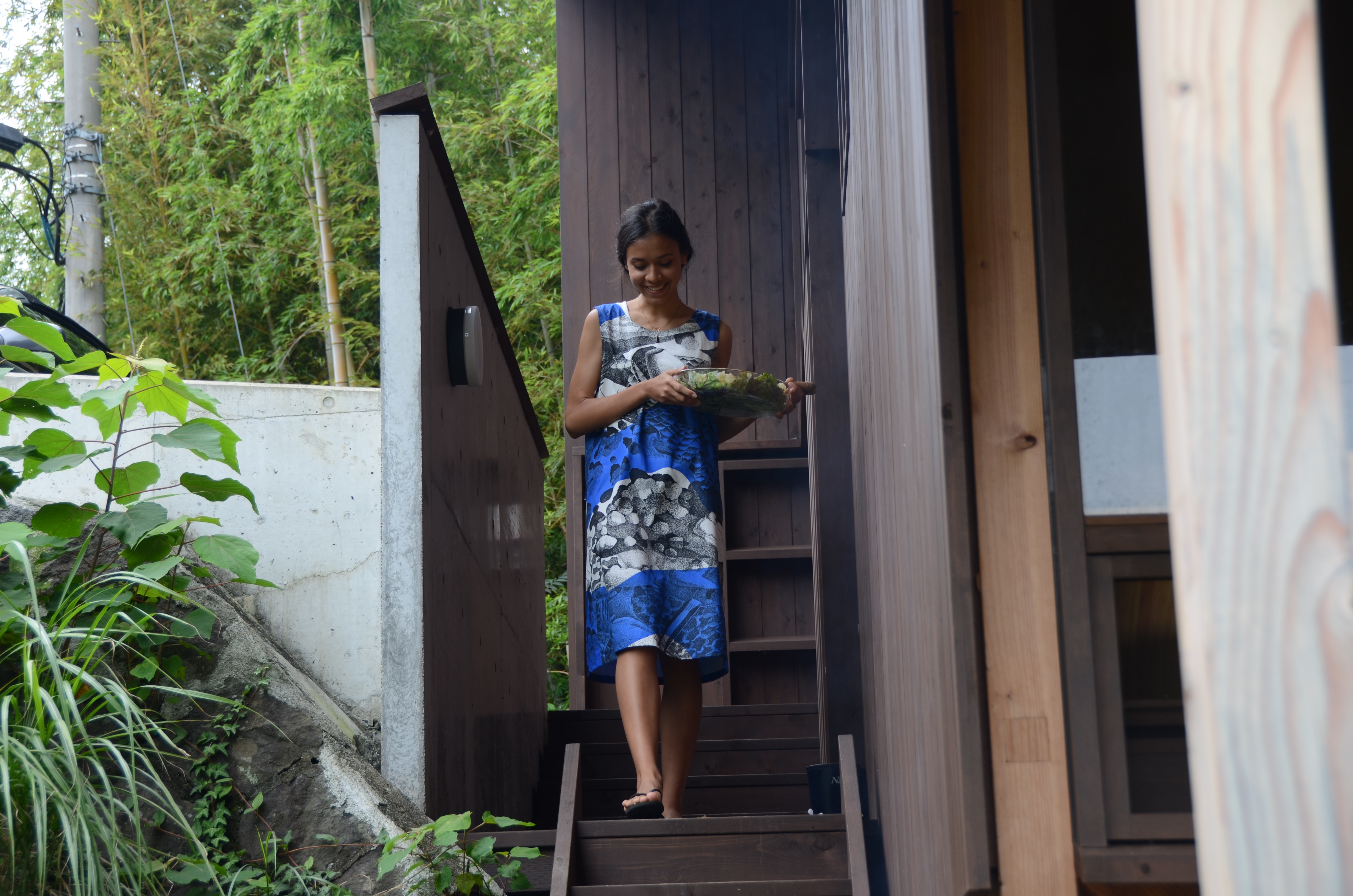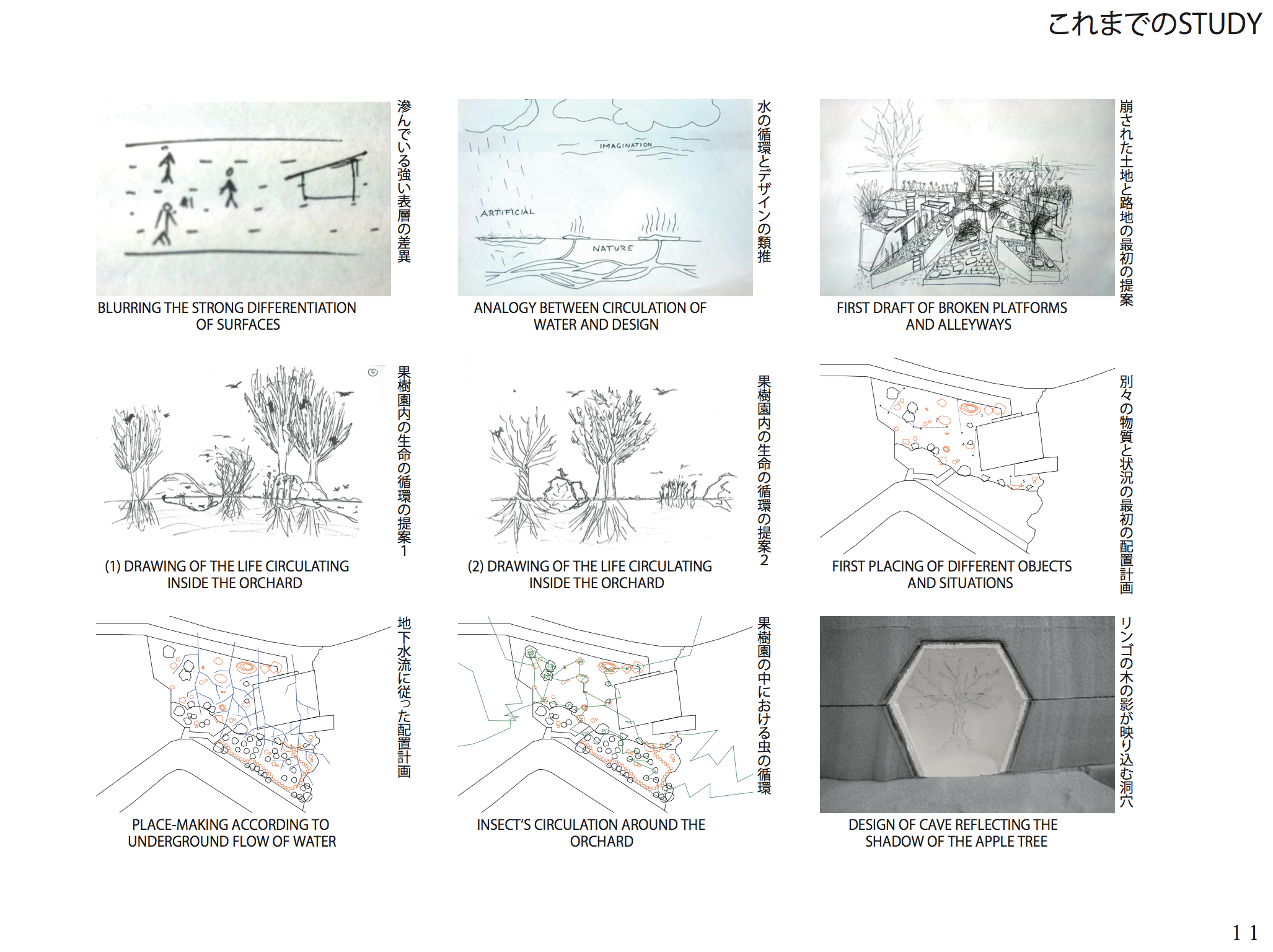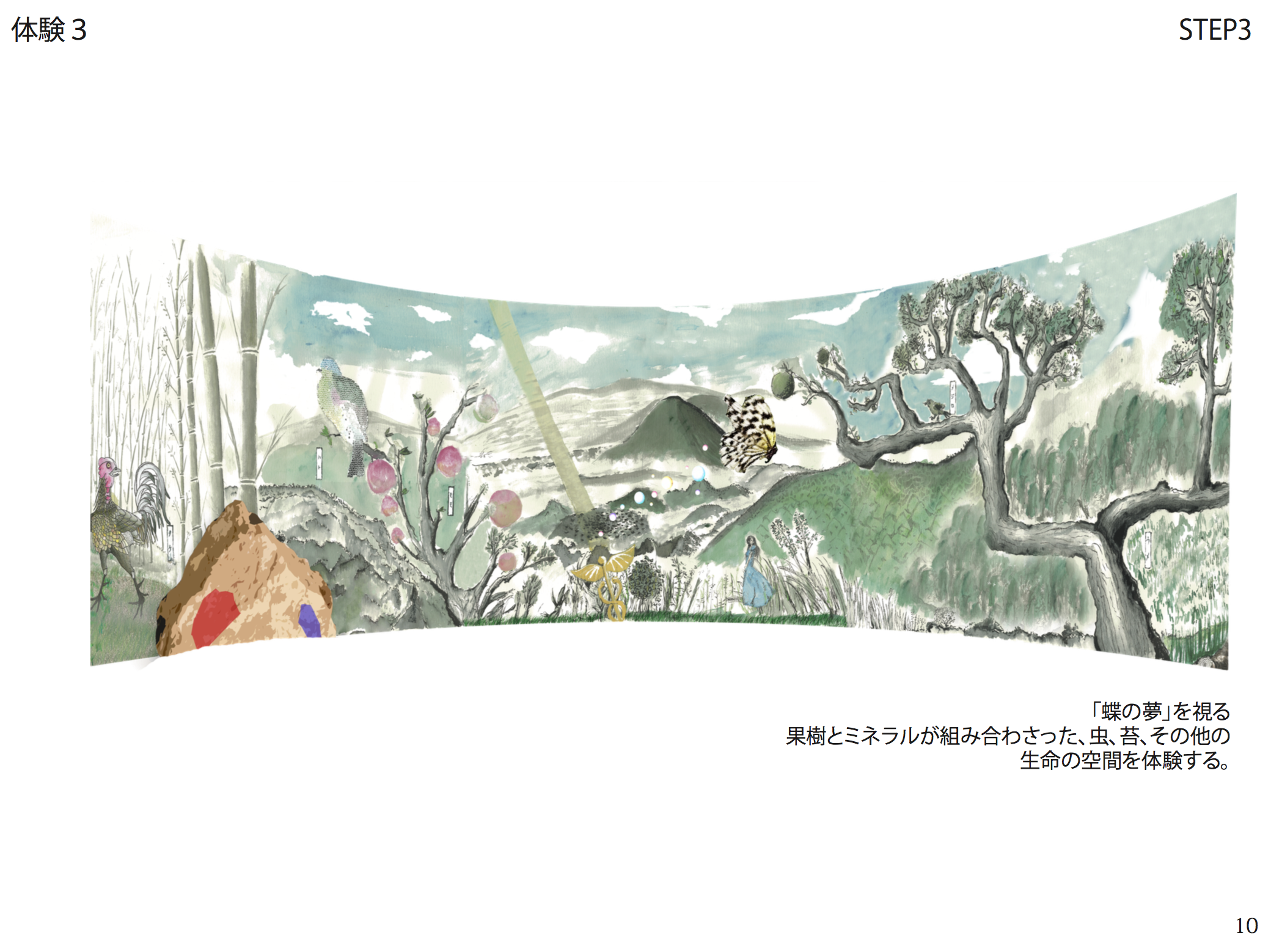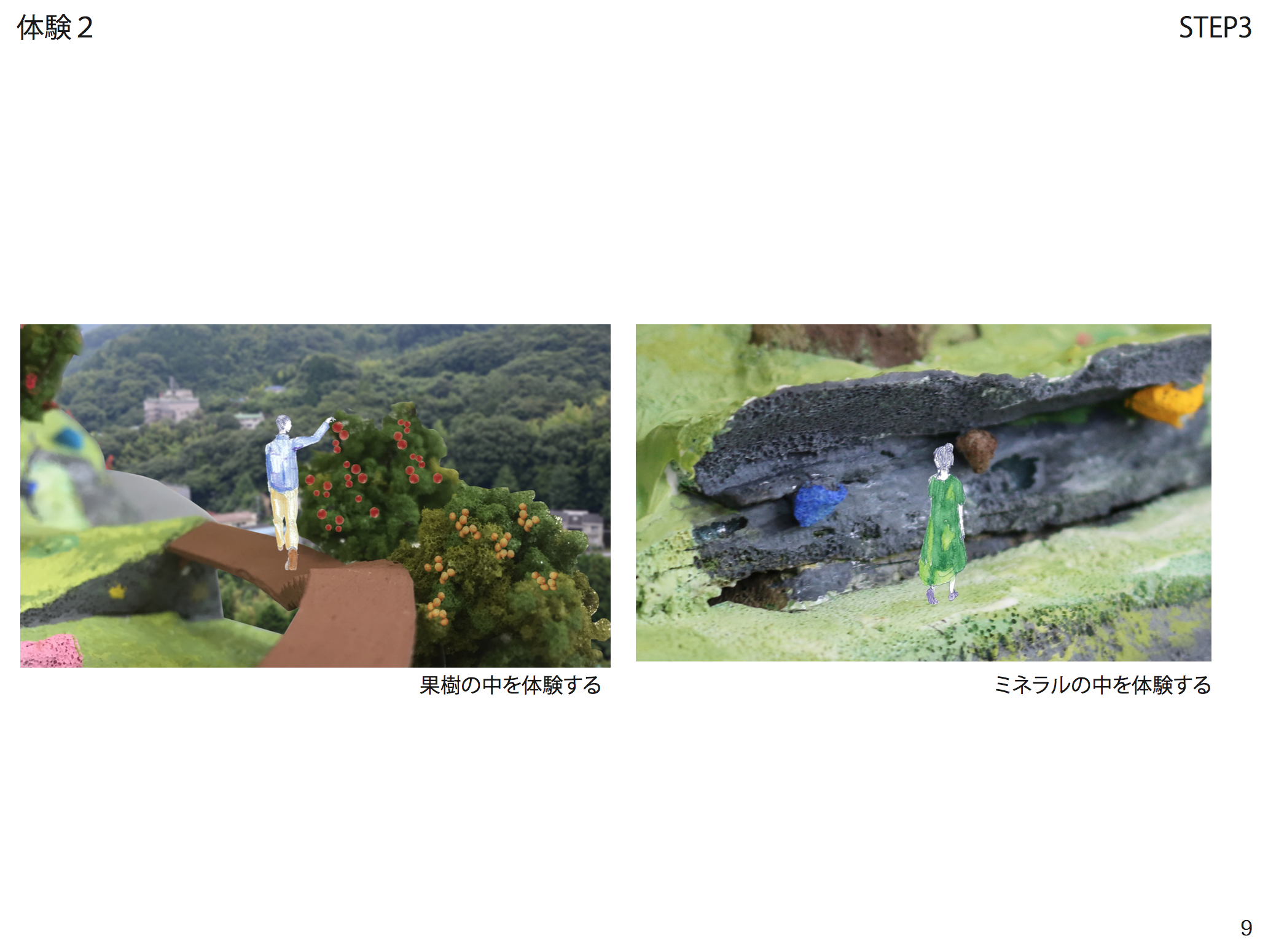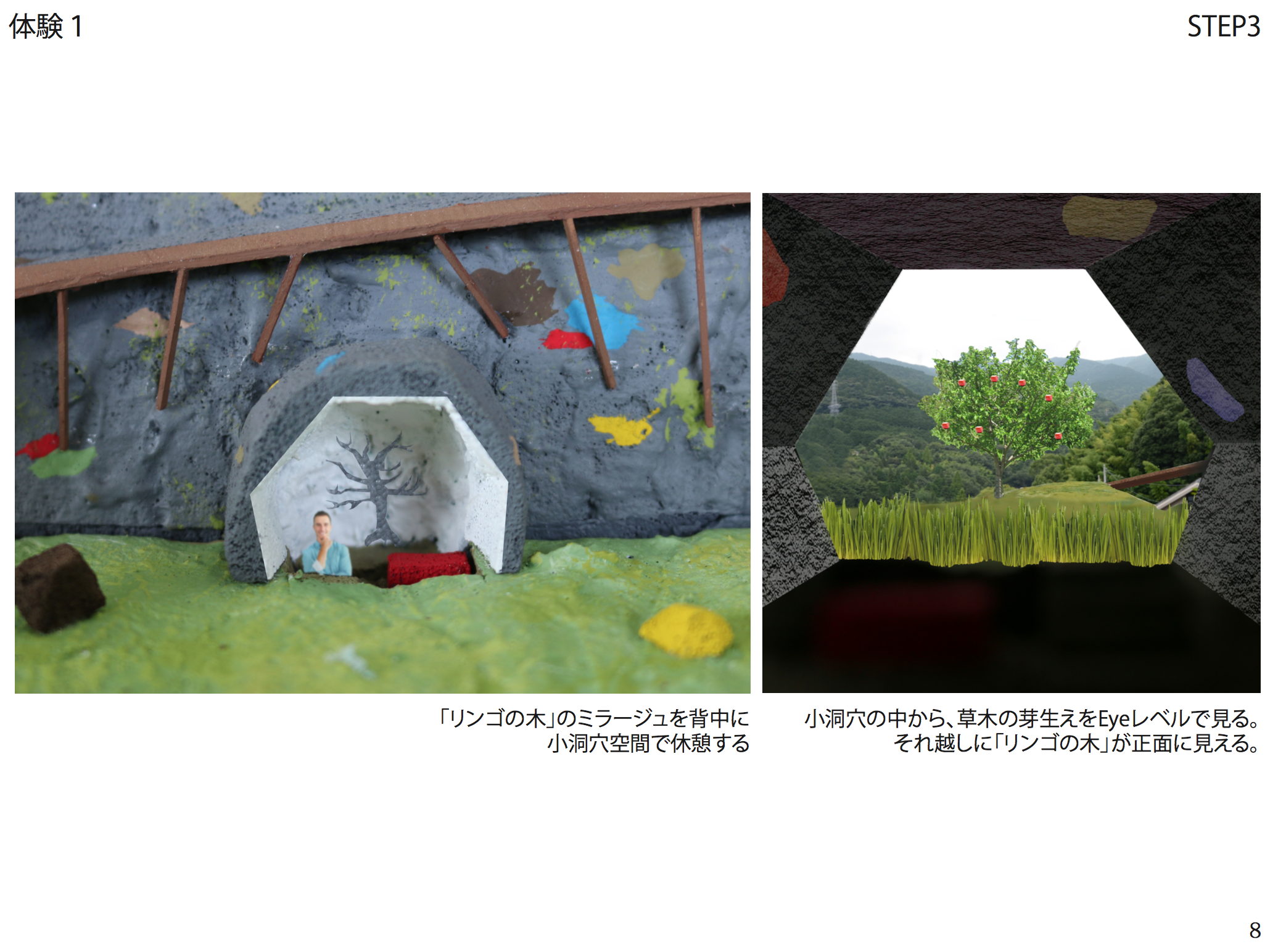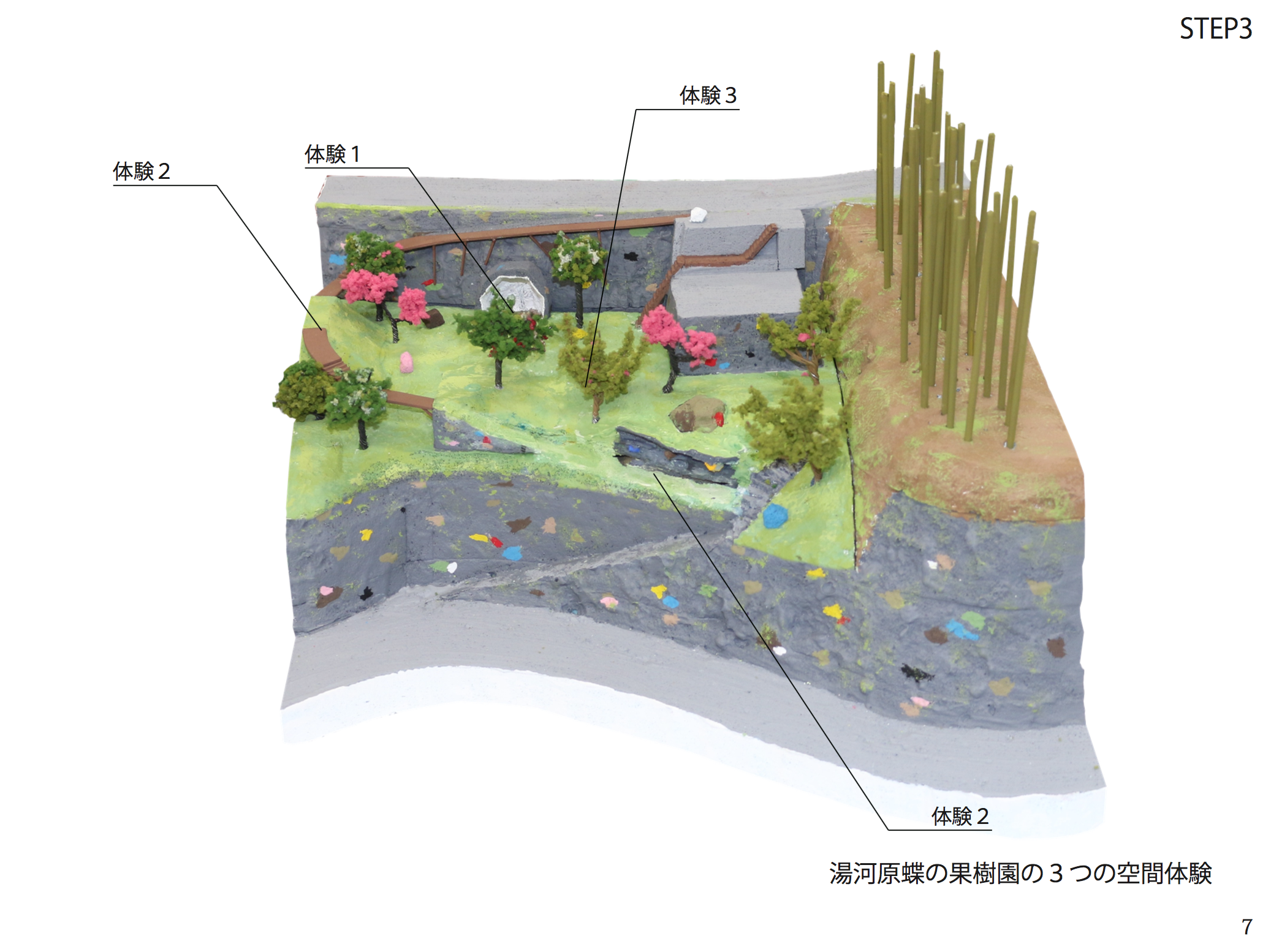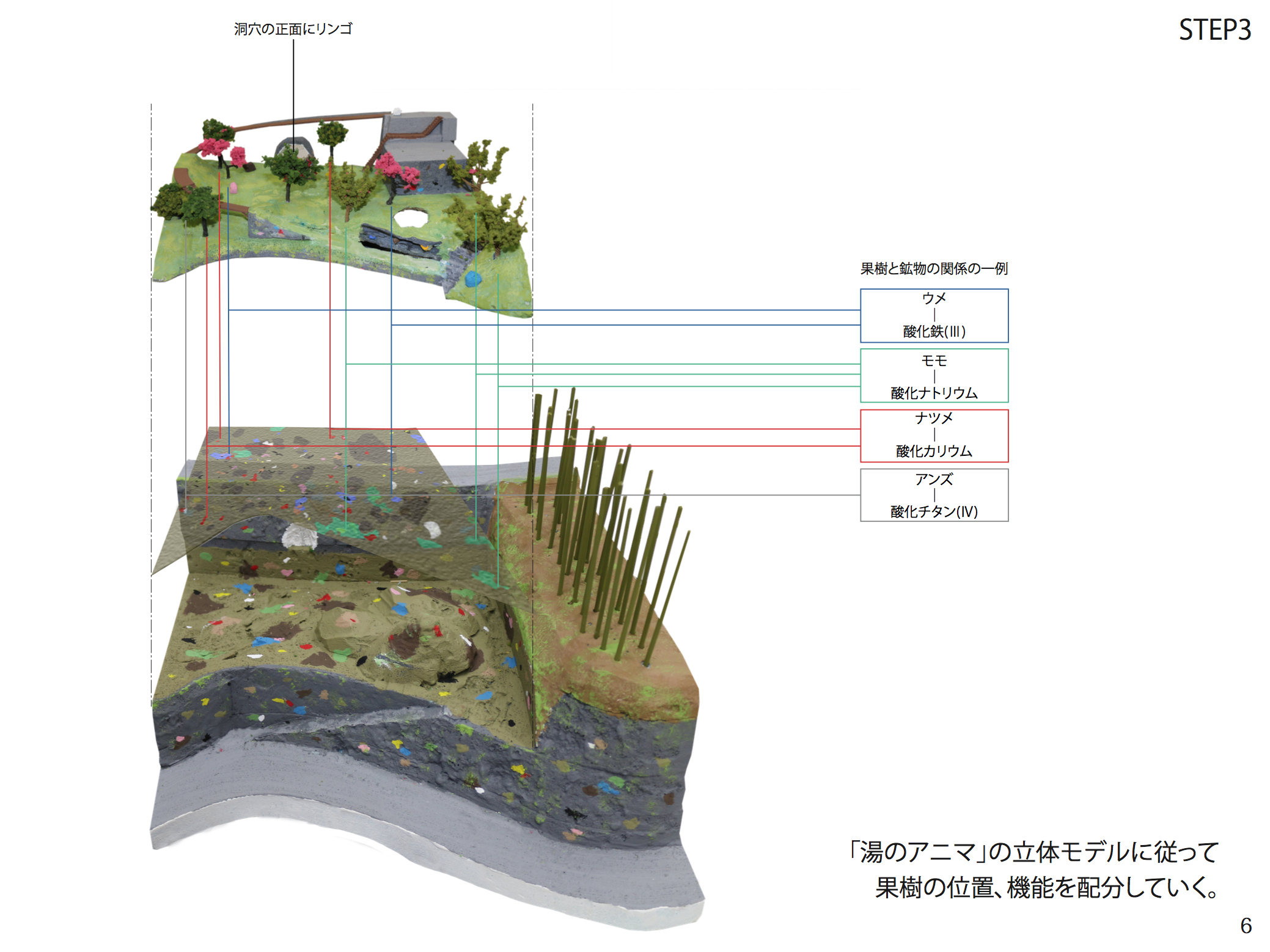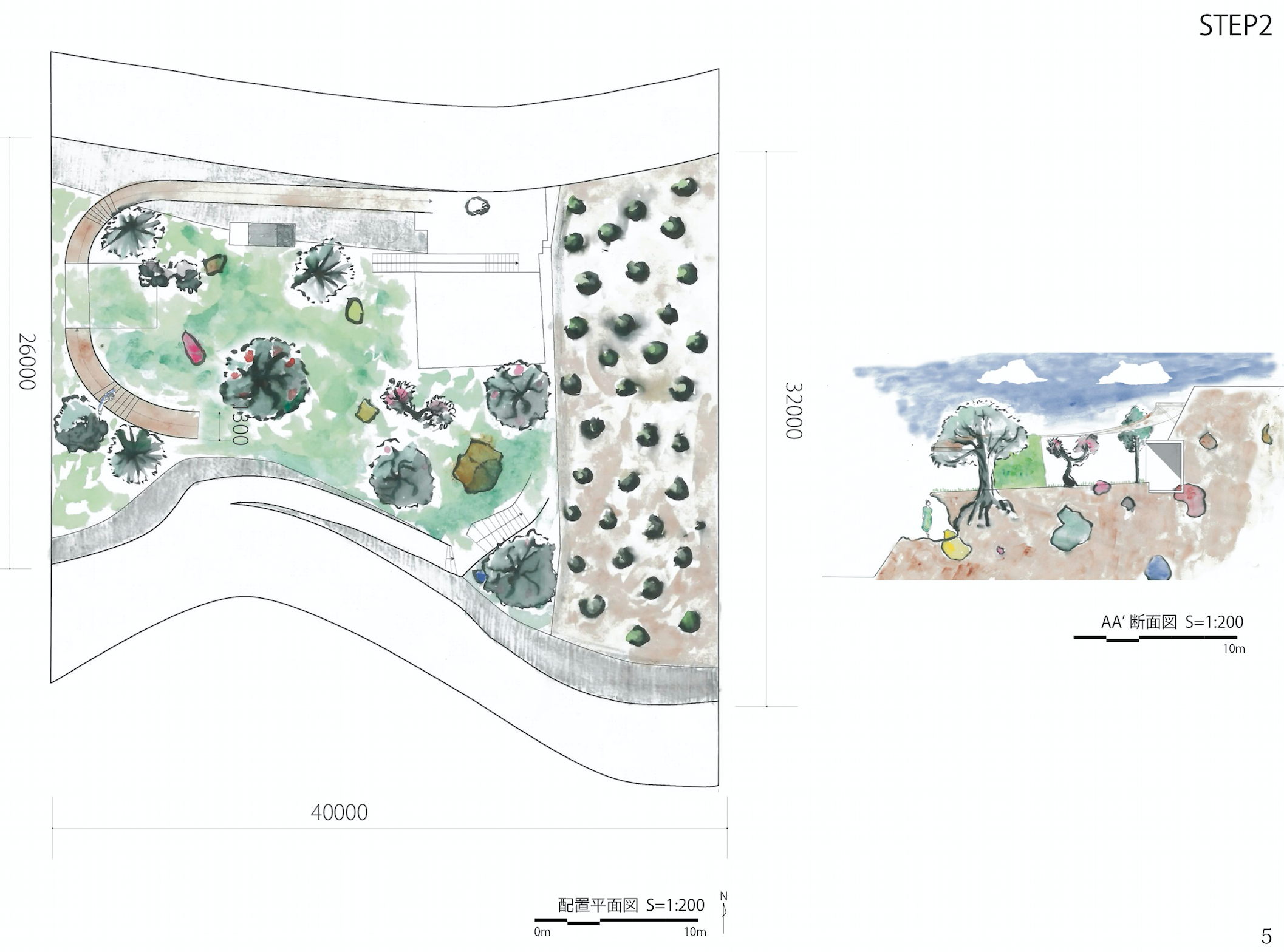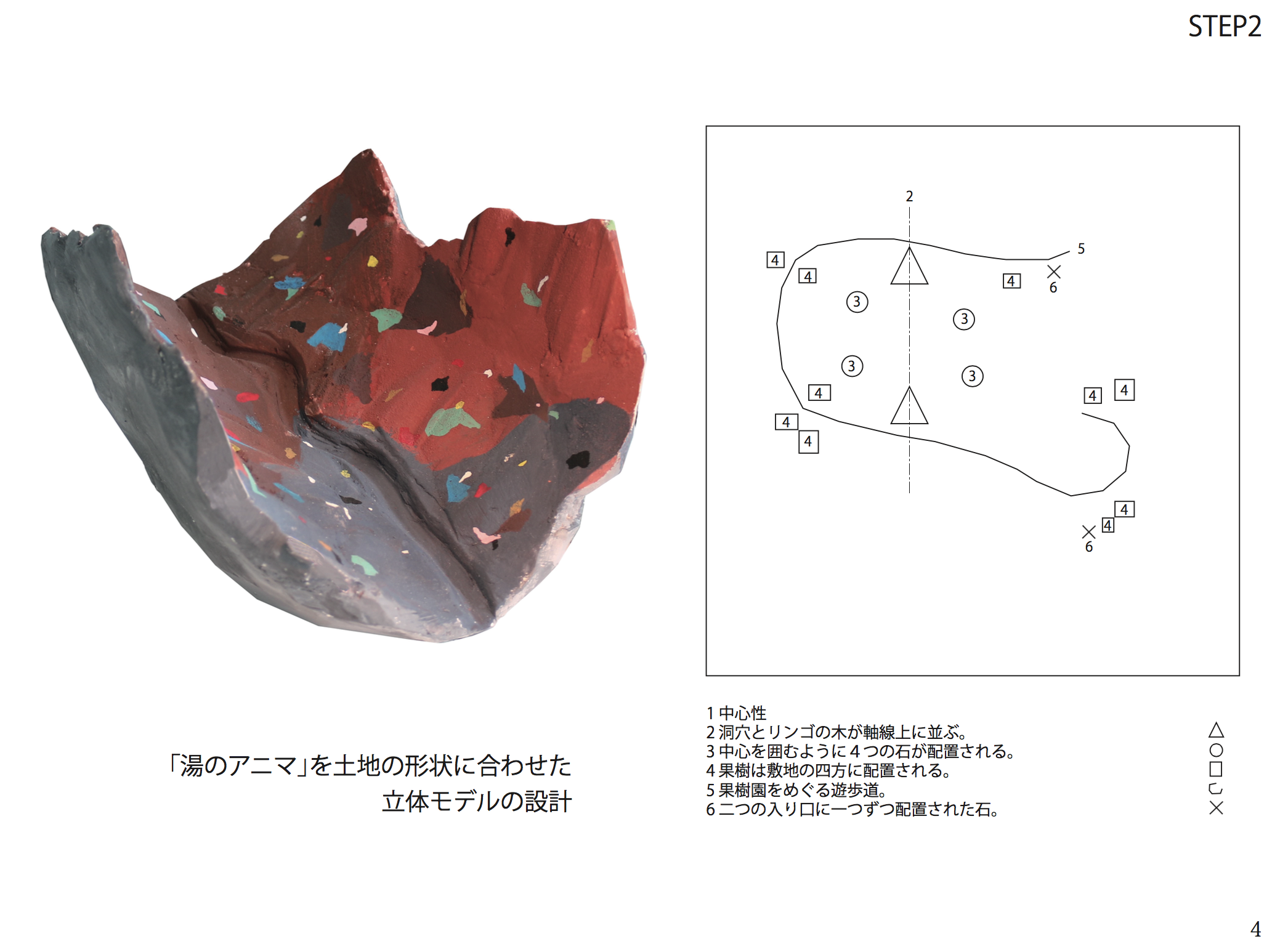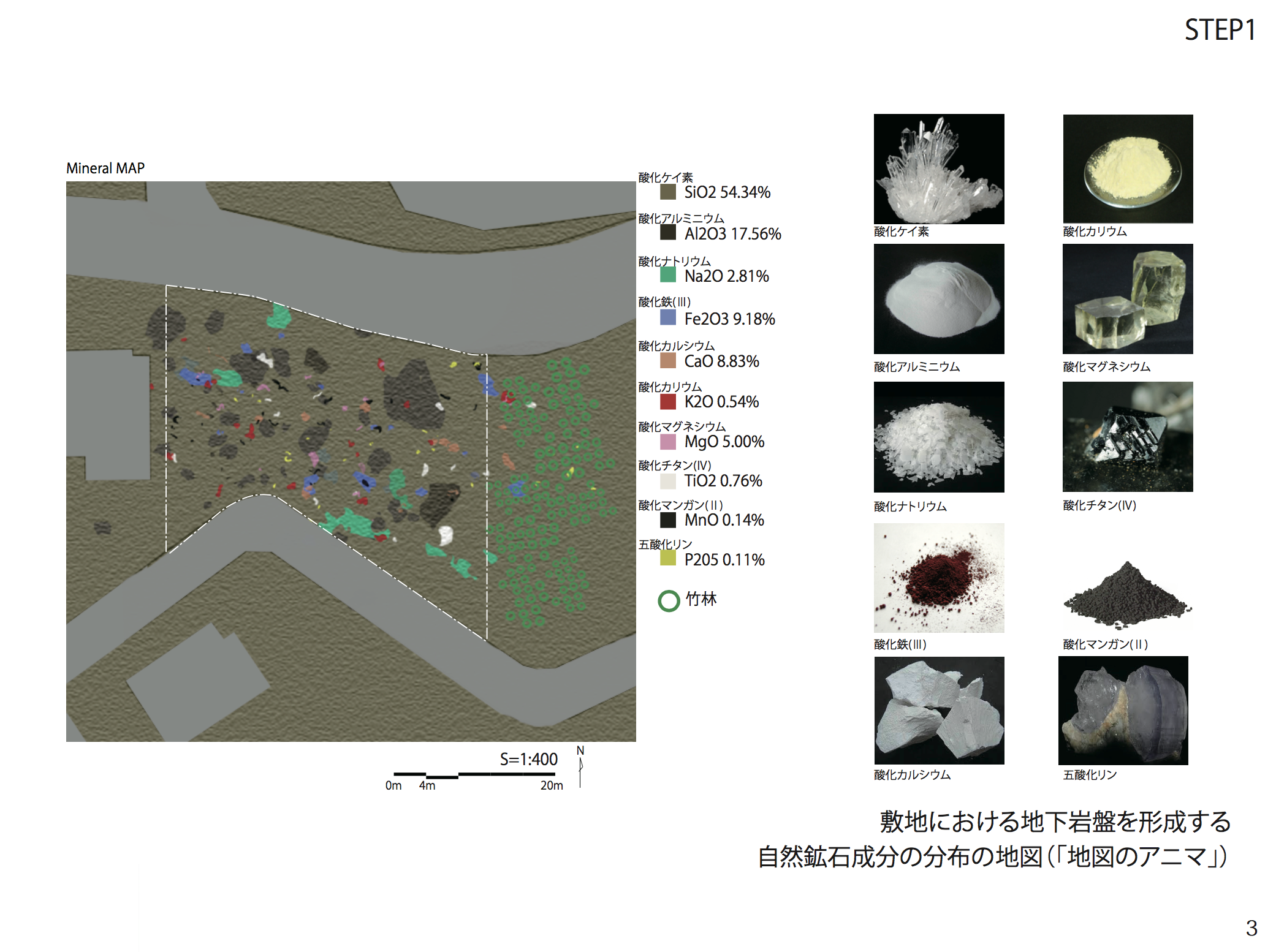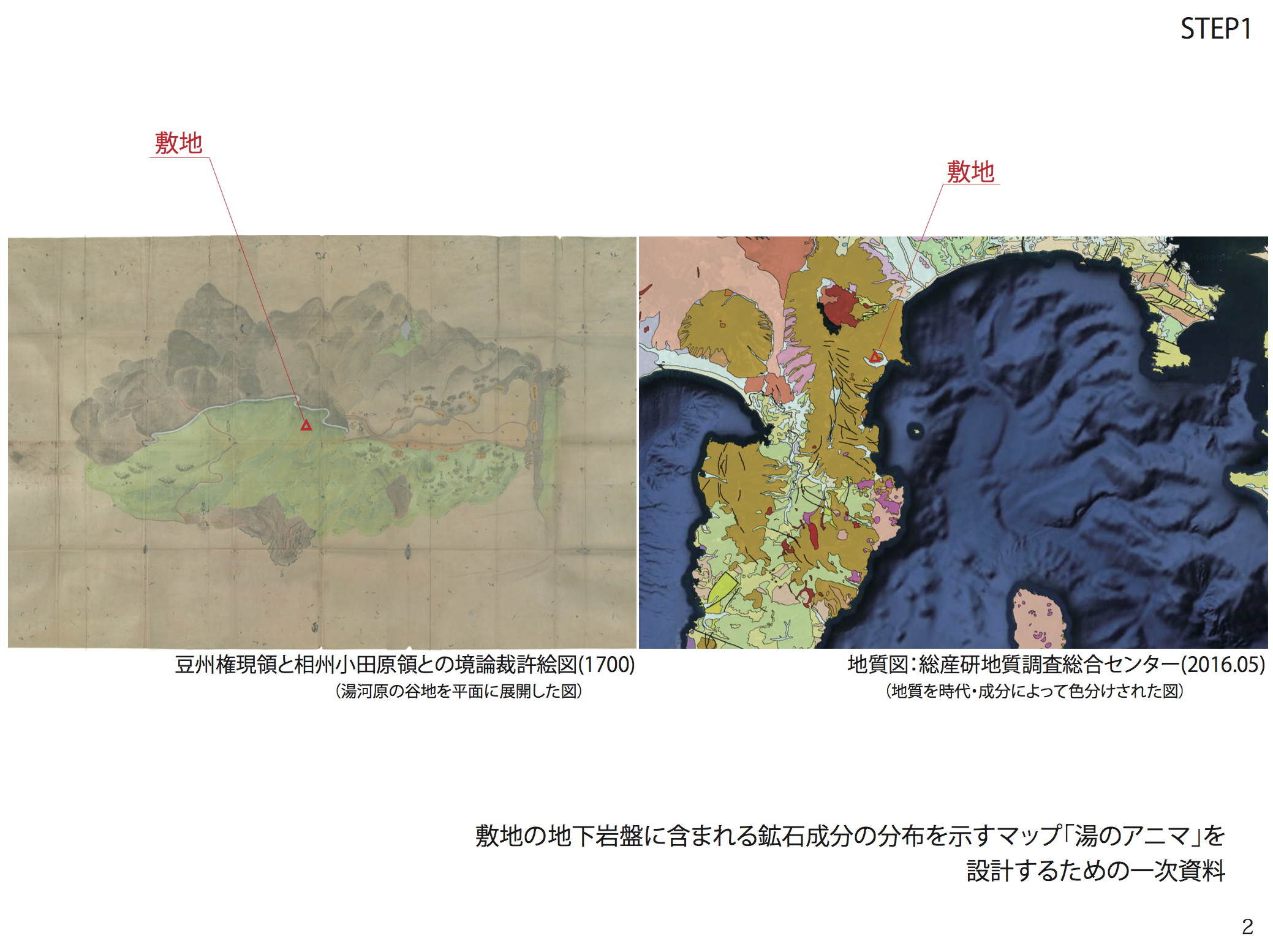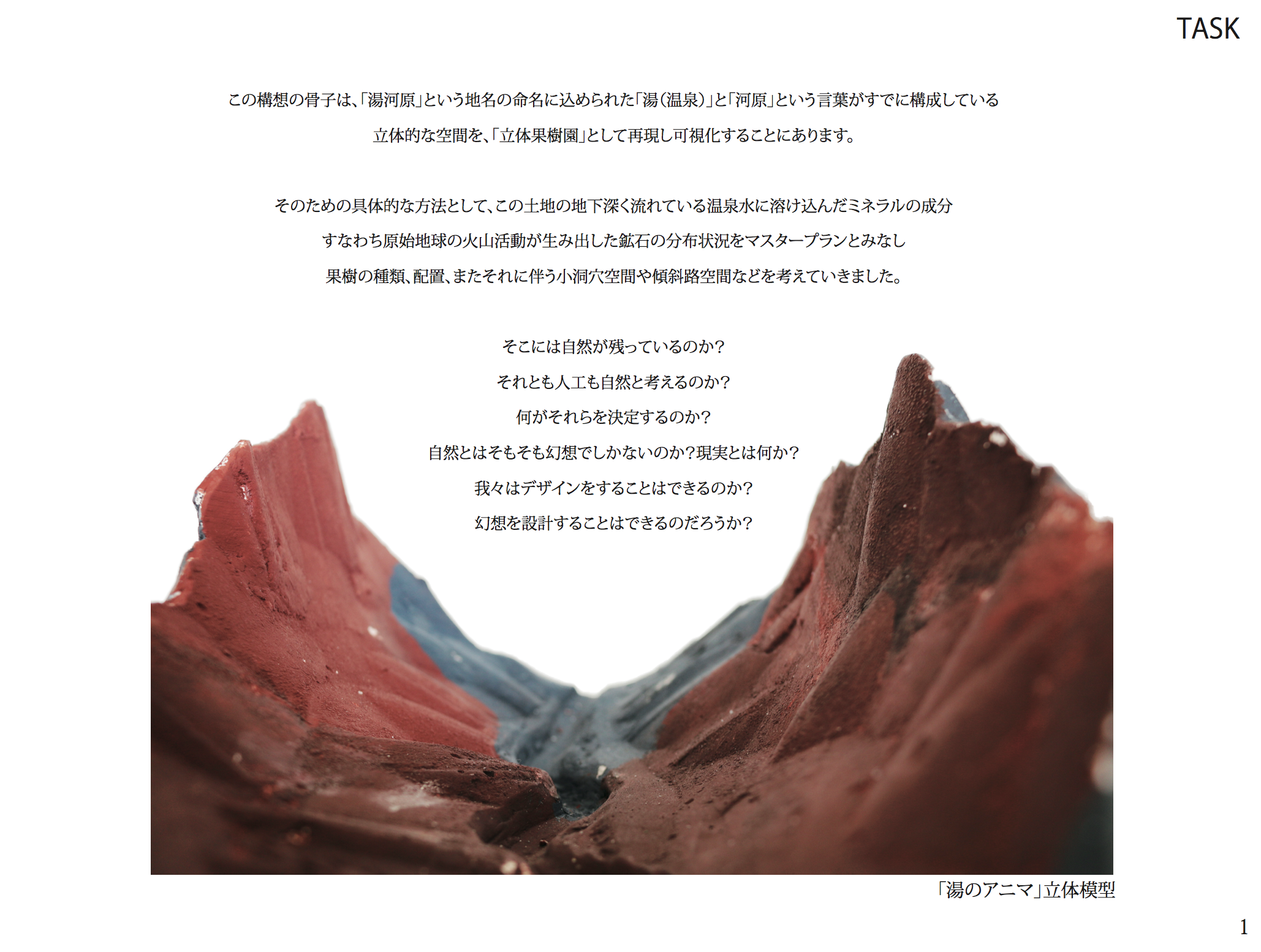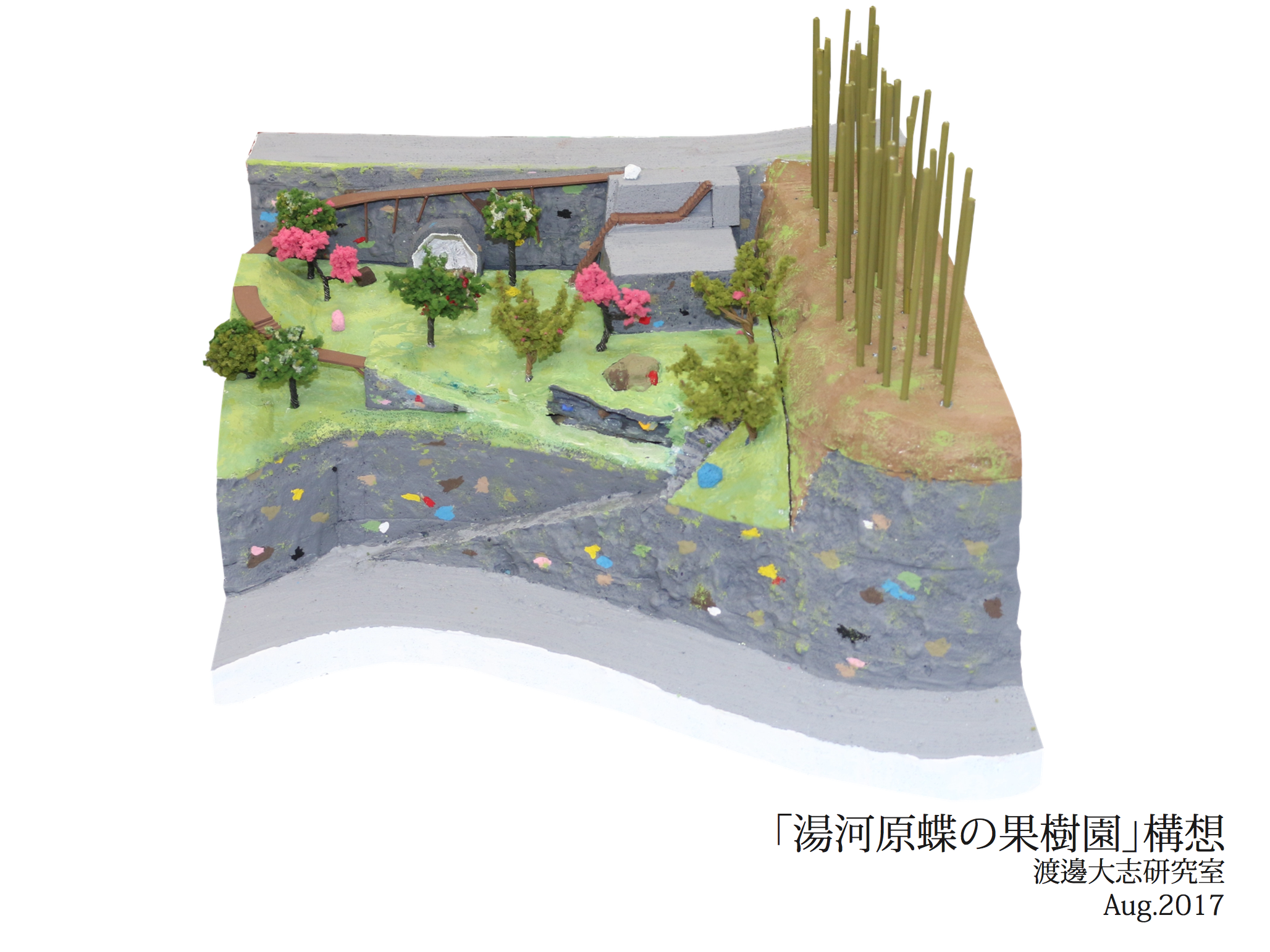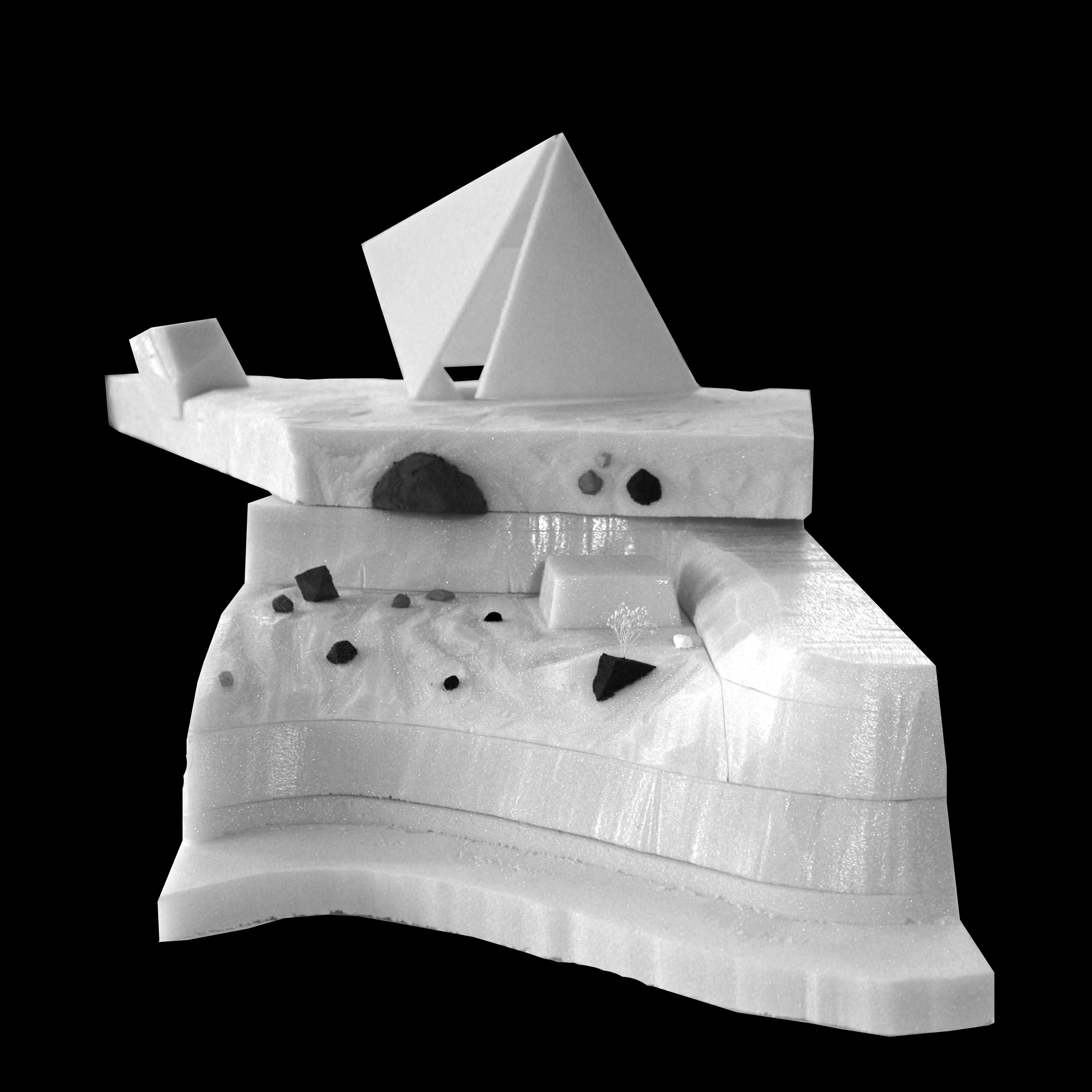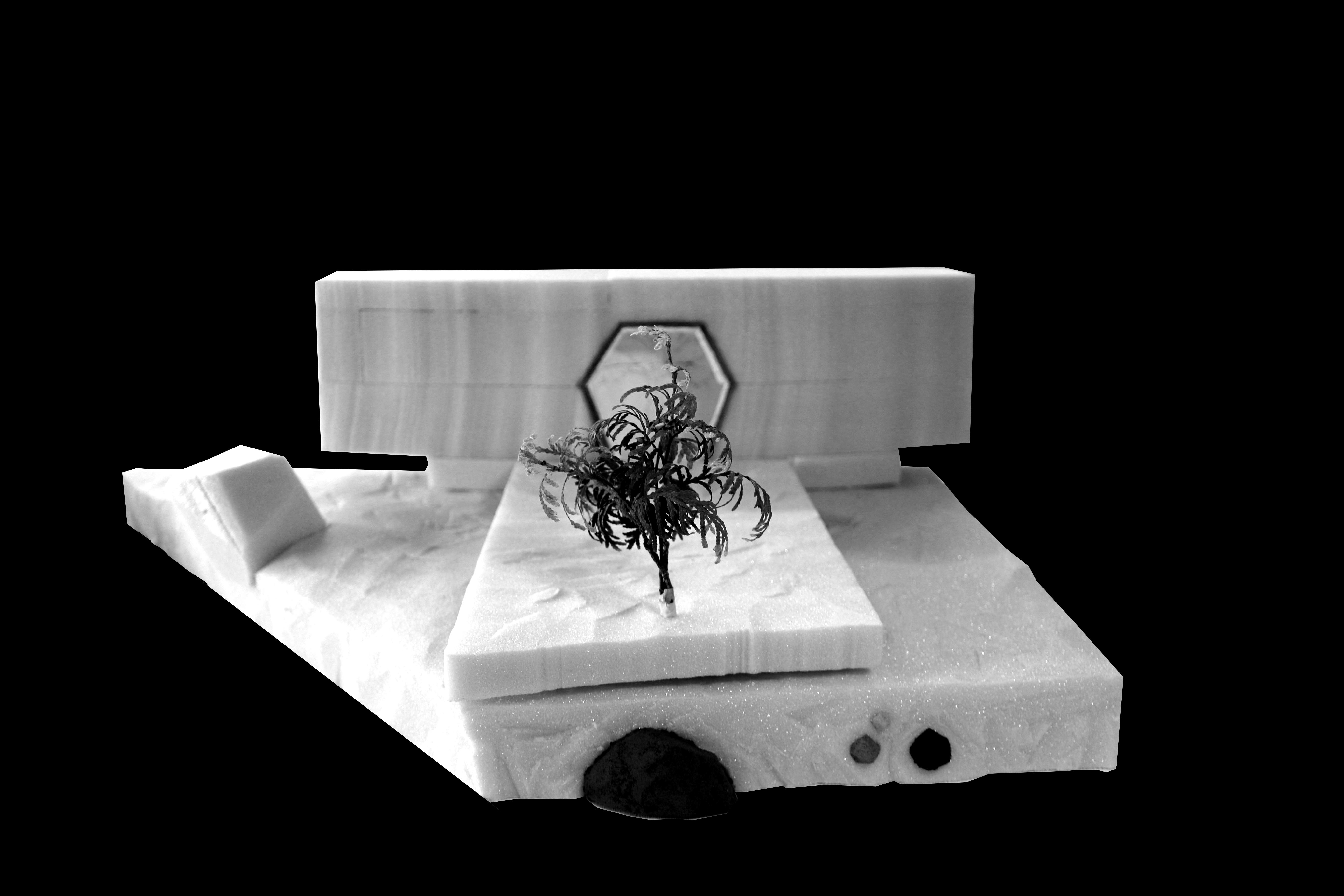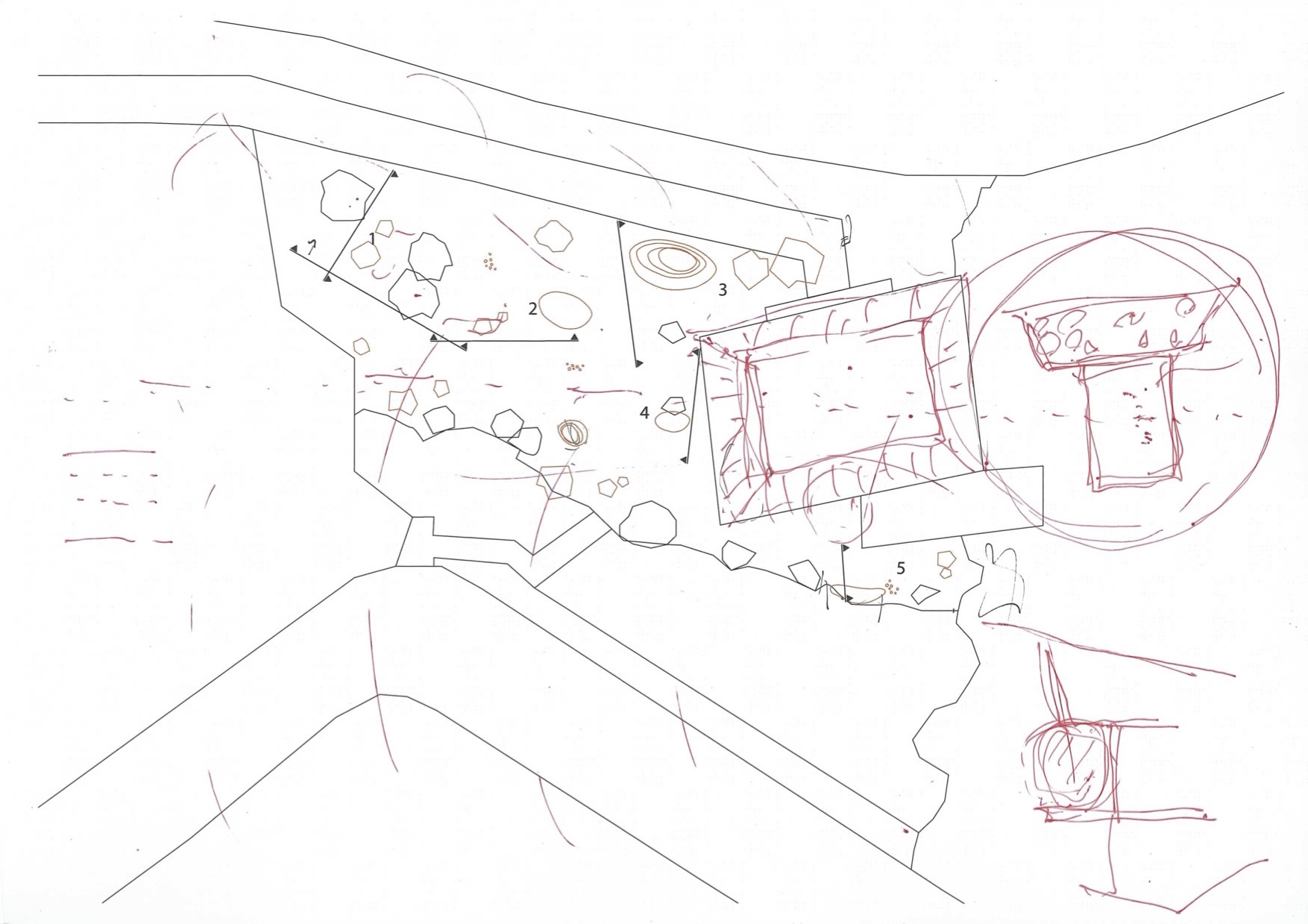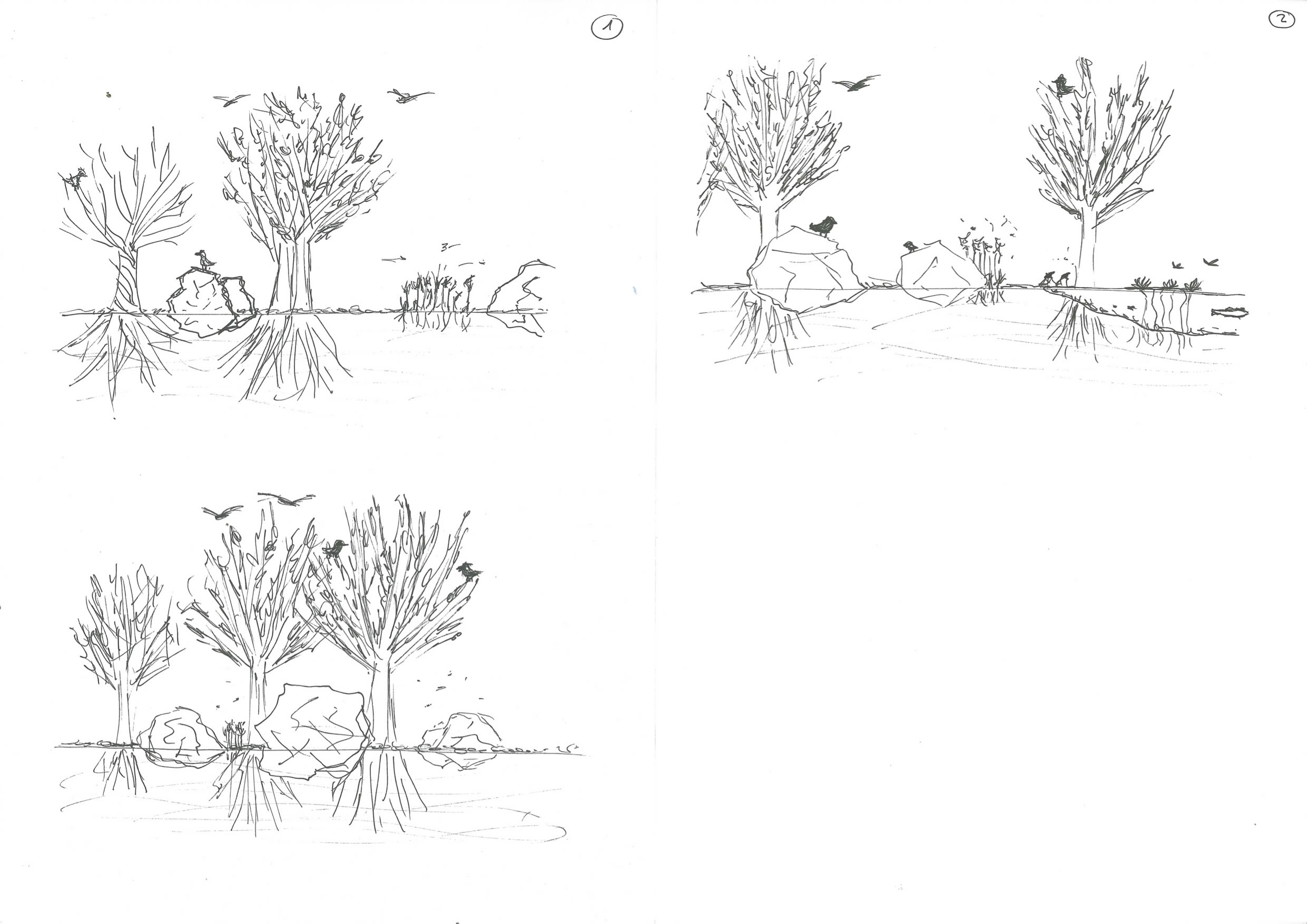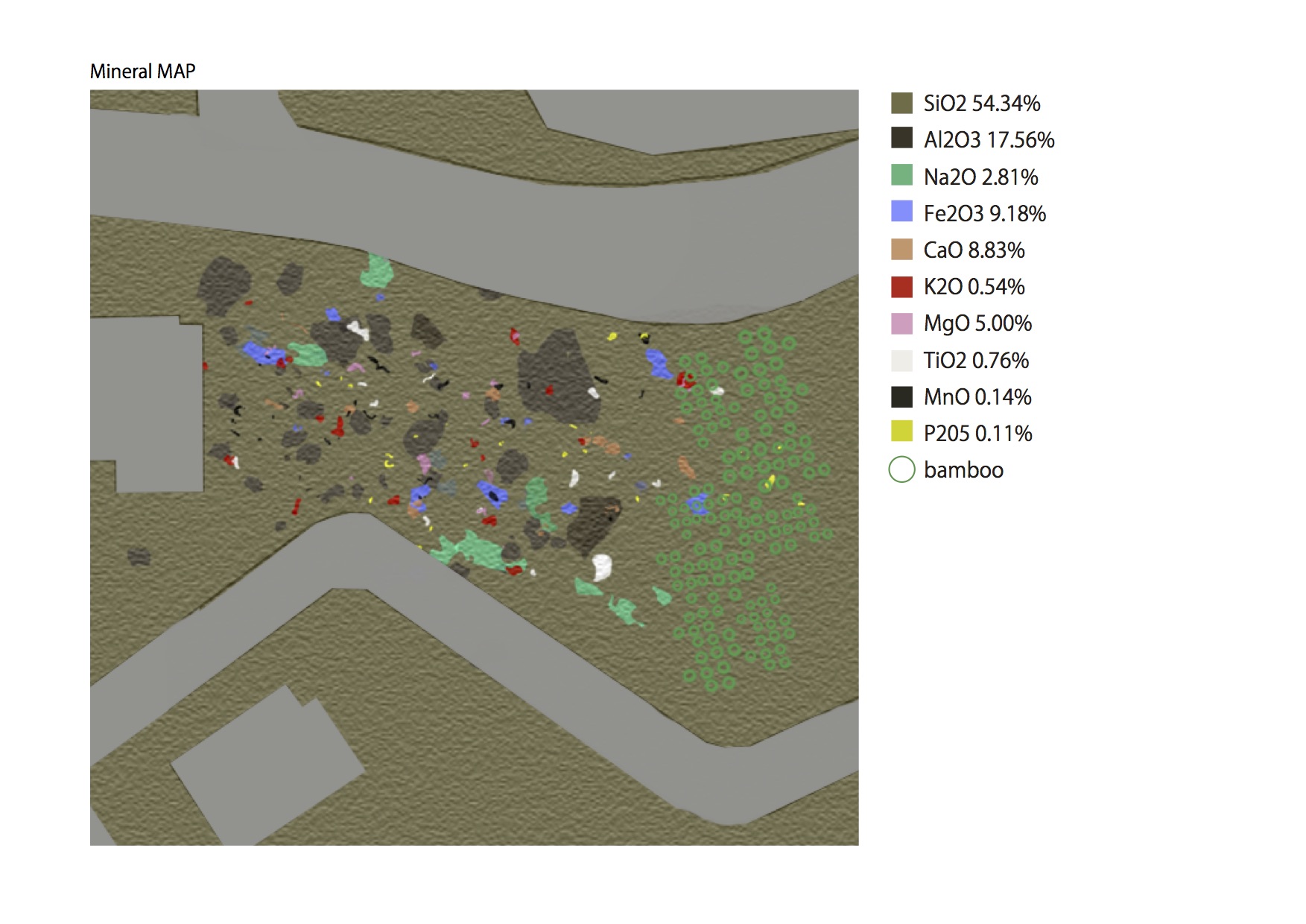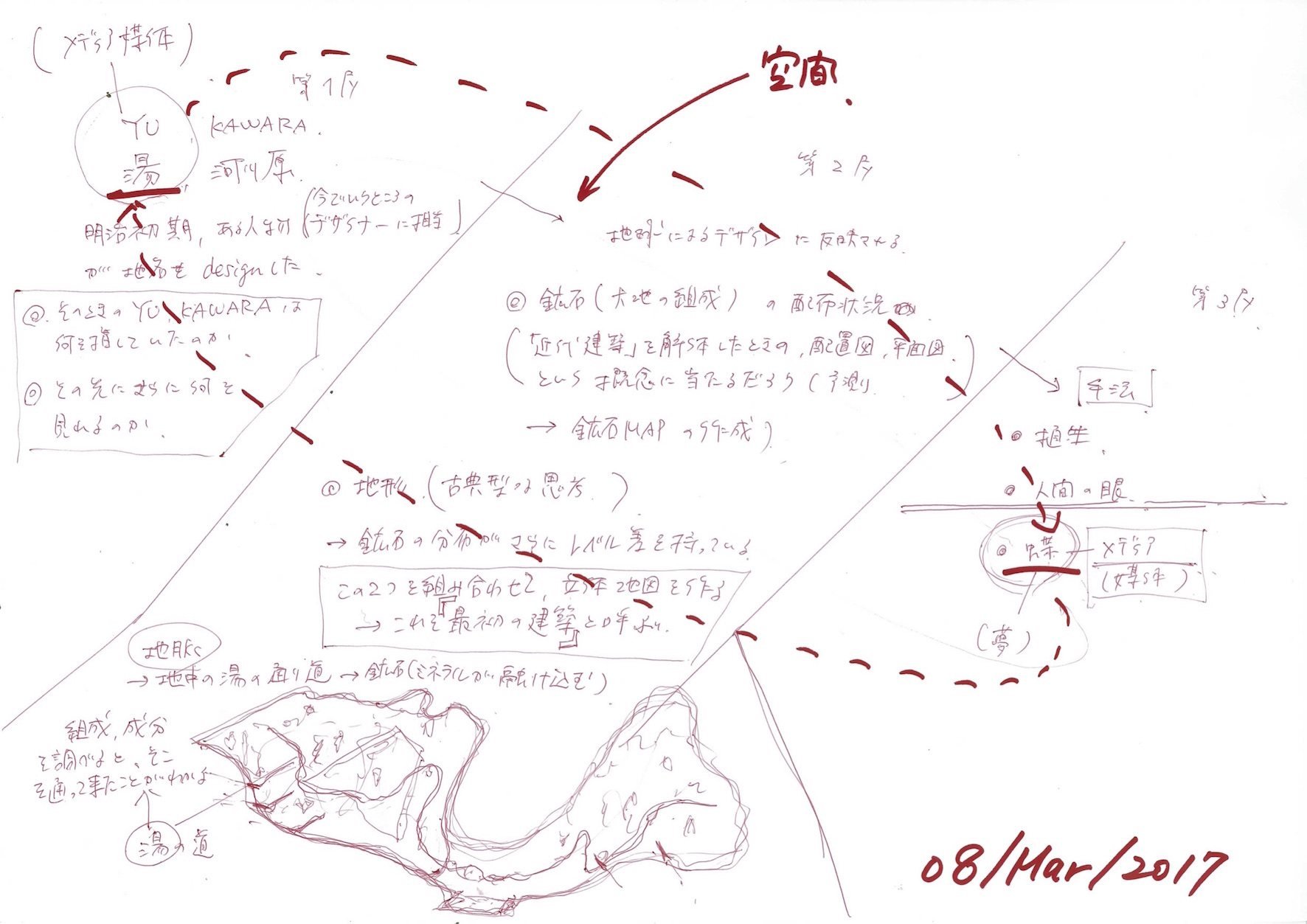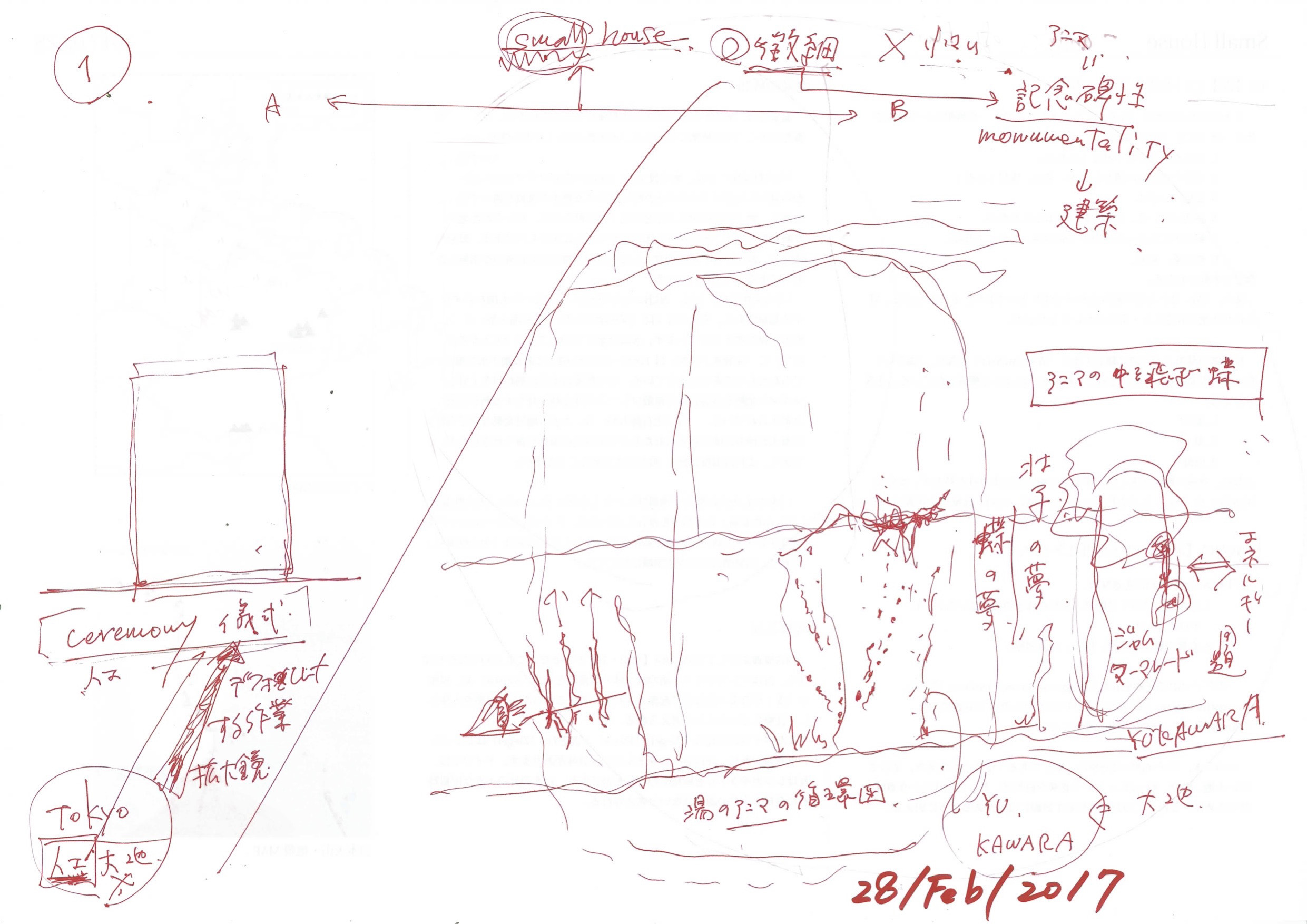渡邊大志研究室
湯河原蝶の果樹園計画|ANIMA OF YU
神奈川県湯河原
2017/06/21 満ちる湯のアニマ ー湯河原蝶の果樹園計画ー 第四稿
ここ湯河原の庭園の大地の中には多くの種類の鉱物が存在している。しかしながら多くの人間は正確にどのようにそれが存在しているのかを見分けることは出来ない。
それらは混ざっているのか、それとも小さな塊を形成してしるのか。地表に現れた小さな岩も地中では氷山のような大きな塊を持つように、それらを正確に目で感じることは難しい。
私たちはそれらを洞窟、ネガティブな形としてデザインする。洞窟の内部には隠れることができ、草木が生える。また敷地内にある大事なリンゴの木がこの洞窟の内部へと影を伸ばすのである。
There are so many different minerals in the ground of the Yugawara Garden, nobody knows what they exactly look like. Is everything mixed up or are there small islands of specific minerals? Are there some hidden rocks, very small or big like the top of a mountain? Can we make them visible or feel-able?
We want to design a negative form of that thinking, maybe a cave. A place where you can hide and see the grass grow. This cave could also refer to the very important apple tree already growing on the site. Maybe the tree could be reflected inside the cave.
Benjamin
2017/06/21
2017/04/10 満ちる湯のアニマ ー湯河原蝶の果樹園計画ー 第三稿
Is there still nature? Or is what we consider being natural already artificial? How could you decide?
Is nature only imagination? What than is real?
Can we do real design? Are we able to design imagination?
In the old times, people believed in gods and nature. People came to the hot springs to improve their health, soldiers came to the hot springs to heal their wounds. Today geology and medicine can prove some positiv effects of the hot springs containing specific minerals good for the body. The placebo-effect has also been scientifically proved.
In architecture we traditionally deal with views and perspectives. In the Yugawara Garden Project we want to take the perspective to the inside. We know that there always will be a certain gap between what is physical real and what we are able to conceive. Also, we want to design the Yugawara Garden Project for all creatures, not just for humans. That’s why we have to imagine how everything would look like through other creature’s eyes. For example, what would the Garden look like for a butterfly waving between the flowers? What would it look like for an ant crawling under the grass?
Through this kind of imagination we want to become more sensitive towards the circulation of things and life in Yu.
As we are thinking about all scales, we also analyzed the specific minerals in the soil of the Yugawara Garden Project. What kind of minerals were delivered to the Garden by the underground flow of water over thousands of years?
Afterwards we designed this map of the distribution of minerals in the ground. Like in traditional Japanese Gardens, we change the scale here again towards the whole Yugawara area, represented in this mineral map and therefor in the design of the small garden itself. So it is most important to keep every perspective in mind, from the smallest mineral in the ground, over the small insects and animals, to the whole valley of Yugawara.
Benjamin
2017/04/10
2017/03/15 満ちる湯のアニマ ー湯河原蝶の果樹園計画ー 第二稿
このプロジェクトの基本は、現在の特に日本の建築家の終焉と建築の非終焉と呼ぶべき状況に対して、西洋/東洋の類型とは異なる建築原理を示す試みである。
そのために前稿に引き続き、湯河原YU-KAWARAという地名に見るアニマの正体を追い続けているわけだが、ひとまずの整理としてそれを大地の組成に見ようと考えた。
大地という抽象名詞は、これは具体的には鉱石の組成の集合である。地中に流れる地球の活動による深層水がその分子間を通り、物質がこれに溶け込むことで湯YUは温泉と呼ばれる。それを初期的に知っていたのは役小角のような修験道の験者や山師といった、現代で言うところの地質学者たちであった。
まずはこの土地の鉱石の分布とそれが、さらに地形によるレベル差を持っていることを表現する地図や模型を作成し、その立体地図を「最初の建築」と呼ぶ事にする。
おそらく、その先にその表皮に自生する植栽などの問題が現れるのではないだろうか。
2017年3月15日
渡邊大志
2017/03/01 満ちる湯のアニマ ー湯河原蝶の果樹園計画ー
今年夏に企画しているベルリンでの展覧会は’small house’を共通アウトプットとし、5-6名の出展者がそれぞれの現在の都市、建築についての考えを述べることにした。期間中のシンポジウム等も含めて、この展覧会はちょうど1年後にドイツで出版する本の編集材料となることを目的としている。
そのことを前提に、研究室からは2つのプロジェクトと今年の国際設計studioGの成果をドイツの方々にご覧いただこうと考えている。
プロジェクトは現在進行中の「住ま居の節会」、「湯河原蝶の果樹園計画」をドイツに持って行こうと思っている。これらは現在の私の都市と建築に対する考えの両極を示すものである。どちらもヨーロッパ伝来の建築という意味でのArchitectureとは異なる空間構築の理論たらんという点は同じである。
「湯河原蝶の果樹園計画」はまず、湯河原という地名から「空間を作るモノ」を抽出しようと考えた。果樹園の形式は意図的である。空間は土地に建てられた建築物の中だけにあるものではない。空間を内包する立体であればそれは庭園でも農園でもあり得る。土地の有り様そのものがすでに空間でもある。特に湯河原の傾斜地はそれがよくわかる土地だ。そしてその地下、つまり地球の内部には温泉となる地下水脈が流れている。
結論から言えば、湯と河原が合成された地名に「空間を作るモノ」としての「湯のアニマ」を見出そうとしている。アニマはアニメーションの語源のラテン語であるが、これは今のところ途中で頓挫してしまっている「精霊計画」の精霊のことである。
地球のマントルからの火山活動によってその内部を流れる深層地下水に鉱物が溶け込み、それが地表に現れて水蒸気・湯気となり、そして雲となって天水を再び地表に降り注ぐ。その天水は何百年かをかけて徐々に地中へと浸透し、再び地下水脈となって流れるだろう。
このような「湯ーYU」の変身の過程がそのまま空間を包含している様を体験できる果樹園を目指す。姿形を湯に宿るは湯のアニマである。そのために私たちはその場所を唯一の場所として特別視する。
建築が有名無名を問はず、ある特殊な空間として立ち上がっていることもまた、そのモノにアニマが宿る故である。伊勢神宮も、出雲大社もそのために私たちは空の倉庫の中に何モノかを視たいと願う。
そのような満ちる湯のアニマの空間に、まずは一羽の蝶を飛ばすことからプロジェクトを始めよう。
2017年02月28日 渡邊大志
BACK
